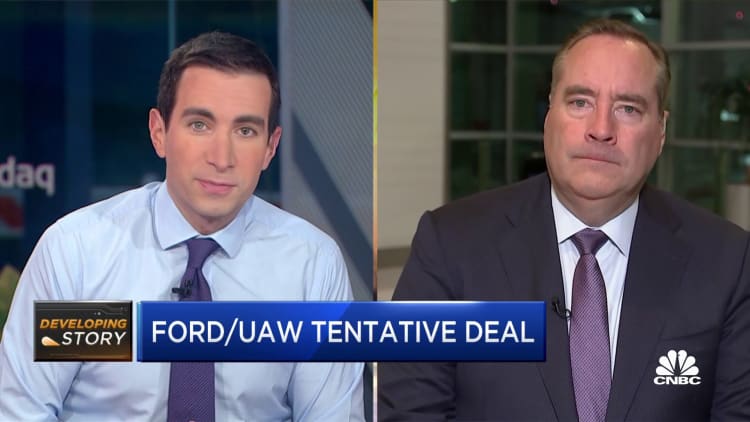[ad_1]
2024 Ford F-150 Raptor
Ford
DETROIT — Ford Motor on Thursday missed Wall Street’s top- and bottom-line third-quarter expectations, as it continues to restructure its business operations and regroups following the end of a nearly six-week U.S. labor strike against the company.
Shares of the company fell about 3% in after-hours trading.
Due to the work stoppage by the United Auto Workers union, which ended Wednesday with a tentative deal, the company pulled its previously announced earnings guidance that included adjusted earnings between $11 billion and $12 billion.
Prior to the strikes, which began Sept. 15, the company was “poised” to hit its earnings guidance, Chief Financial Officer John Lawler said.
Here are Ford’s third-quarter results.
- Adjusted earnings per share: 39 cents per share vs 45 cents per share expected by LSEG, formerly known as Refinitiv.
- Automotive revenue: $41.18 billion vs $41.22 billion expected by LSEG.
For the third quarter, Ford reported net income of $1.2 billion, or 30 cents a share, compared to an $827 million loss, or 21 cents a share, a year earlier. Adjusting for certain items, per-share earnings were 39 cents.
Ford’s traditional business operations, known as Ford Blue, earned $1.72 billion during the quarter, while its Ford Pro commercial business earned $1.65 billion. Its “Model e” electric vehicle unit lost $1.33 billion from July through September.
Lawler said the UAW strike has cost the company $1.3 billion in lost production to date, including roughly $100 million during the third quarter.
Aside from earnings, Wall Street will be watching the impact of the United Auto Workers union’s nearly six-week strike against the automaker.
Barclays analyst Dan Levy estimates the total strike impact to Ford was $600 million to $700 million. That would be less than the $800 million impact, including $200 million in the third quarter, GM reported Tuesday.
“While we await final details, the headline terms appear inline with our expectations entering the strike, and likely priced into the stock,” Levy said in an investor note late-Wednesday.

The overall cost increase of the agreement, which must still be ratified by members, is estimated to be $6.2 billion over the terms of the four-and-a-half-year deal, according to Deutsche Bank.
Lawler declined to estimate how much the deal, which still must be ratified by UAW members, is expected to cost the company under the four-and-a-half-year term of the deal.
The deal includes 25% pay increases over the terms of the agreement, including an initial increase of 11%. The raises and benefits cumulatively raise the top wage to more than $40 an hour, including an increase of 68% for starting wages to over $28 an hour.
It also includes reinstatement of cost-of-living adjustments, a three-year path to top wages and right to strike over plant closures. among other significantly enhanced benefits.
The Detroit automakers have been navigating ongoing strikes by members of the UAW after the union and the companies failed to reach tentative labor deals by a Sept. 14 deadline for contracts covering 146,000 workers.
UAW said Wednesday night that Ford workers who were on strike will return to work during voting, putting pressure on GM and Stellantis to agree to the terms of the tentative agreement.
— CNBC’s Michael Bloom contributed to this article.
[ad_2]
Source link
